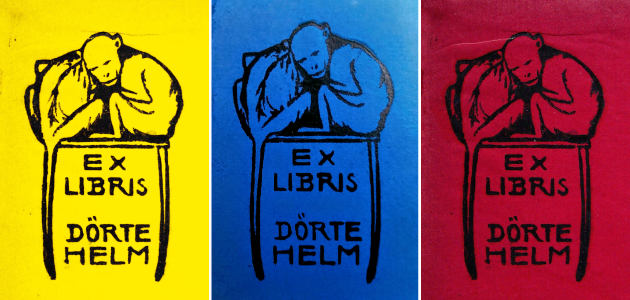Life and Work of Dörte (Dorothea) Helm
December 3, 1898
Born in Berlin-Wilmersdorf as daughter of classical philologist Prof. Dr. Rudolf Helm (1872 – 1966) and his Jewish wife Alice Caroline, born Bauer (1873 – 1947)
1910
Completion of education at the ‘Städtische Mädchenschule’ Berlin – Steglitz
1913
Certificate of eligibility for higher education at the ‘Lyzeum’ in Rostock after Rudolf Helm was called to be on an academic chair at the University of Rostock
1913 until 1915
Arts school ‚Kunstgewerbeschule Rostock‘
1915 until 1918
Arts academy ,Kunstakademie Kassel‘
1915/1916
A semester’s course in the art of modelling with C.H. Bernewitz
1916 until 1918
Student of painter Ernst Odefey
Teaches drawing lessons at a boarding house for women on the side of her education
1918 until 1919
Großherzogliche Kunstschule in Weimar, student of Walter Klemm
1919
June 23, following the council of masters’ decision, admission as ‘apprentice’ at the newly founded Staatlichen Bauhaus Weimar
Her teachers (masters) are at first L. Feininger and J. Itten (in the preparatory course) “Vorkurs”
Work and engagement at the student magazine of the Bauhaus ‘Der Austausch’ (‘the exchange), which was published in few editions throughout May, June, and July (among others, a contribution for the equal rights and treatment of women at Bauhaus)
Participation in a competition of the Bauhaus Signet (earned 3rd place)
1920
Fabrication of political propaganda signs in the rooms of the Bauhaus for the victims of the Kapp putch.
First exhibition in Rostock
Joining the mural workshop of the Bauhaus in the summer semester (Form Masters J. Itten and O. Schlemmer)
Decorating with paint of a sculpture by Adolf Brütt on the square in front of the Bauhaus’ workshop building, together with the students Heinz Borchers and Robert Franke. The conservative public in Weimar protested and the Bauhaus had to react. Borchers and Helm were officially suspended for the summer semester due to ‘recklessness and disrespect’ – both continued studying and enrolled officially again for the winter semester 1920/1921.
1921
Her children’s book „Im Märchenland” with her father’s verses is published
Contribution to the project “Haus Sommerfeld” by Walter Gropius (implementation of a big drape, as well as consulting and organizational contribution to the interior design)
1921 until 1922
typography course with L. Schreyer
1922
Apprenticeship certification (Gesellenprüfung) obtained as decorative painter (Dekorationsmaler) in the painter’s and varnisher’s association of the Chamber of Crafts Weimar (afterwards budgetary fellow at the Bauhaus) “Etatgeselle”
Contribution to the layout and color design for the painting of the Gropius building “Haus Otte”
1922 until 1923
Fall until summer work in the weaving workshop. Learning two forms of tapestry weaving
Attends several seminars: J. Itten’s ‘Analysis of old masters’, W. Kandinsky’s ‘Form and color theory’, W. Gropius and A. Meyer’s ‘Dimensional and practical industrial drawing’, P. Klee’s ‘About problems concerning forms’
1923
Contribution to the exhibition commission of the great exhibition of the Bauhaus in Weimar. Represented there with a four-part screen with textile and a wall hanging in strict geometric form designs
Contributes as only woman to the 20-part series of advertising postcards for the Bauhaus exhibition in 1923 (total number of copies: 40 000)
1924
Return to Rostock
Member of the exhibition leadership of the society of artists in Rostock (VRK, Vereinigung Rostocker Künstler), contributes to and participates in annual exhibitions until 1931
Self-employed as interior decorator and painter
Member as painter and graphic designer in the economic association of visual artists (“Wirtschaftlicher Verband bildender Künstler”)
1925
Longer stays in Ahrenshoop
1926
Design and plan of an abstract-constructivist stained-glass window for the summer house of the befriended Hinstorff publisher Perter E. Erichson (at “Am Schifferberg 10” in Ahrenshoop)
1927
Exhibition at the „Güstrower Heimatmuseum”
1927/1928
Interior Design of the Kurhaus in Warnemünde, together with architect Walter Butzek (including murals, which were destroyed after 1933)
1928
Special exhibition at the yearly exhibition of the VRK dedicated to architecture
Longer journeys and stays in Switzerland and Austria
Meets her future husband, journalist Heinrich Heise (1899 – 1944)
1929
Interrior Design of the student house’s cafeteria of the university in Rostock
Participation at the “Kunstblatt” exhibition of young artists in Berlin
1930
Marries Heinrich Heise: now Dörte Helm-Heise
Participation at the “Werbekunst” exhibition at the art society in Rostock
1931
Premiere of her fable play “König Drosselbart” at the city theater in Rostock, for which she had also designed the stage sets
1932
Moves to Hamburg
1933
Forbidden to work as ‚Half-Jew’ per law of the Reich Chamber of Culture (“Reichskulturkammergesetz”)
From this point on work as author under alias and interior architect for friends
1938
Birth of her daughter Cornelia Dorothea
February 24, 1941
Dörte Helm dies due to a flu
2020
Dörte Helm is honored by being taken into the women’s garden (“Garten der Frauen”) at the cemetery, which reminds of significant women in Hamburg’s history. Her headstone is modeled on a cubed seat she had designed.

